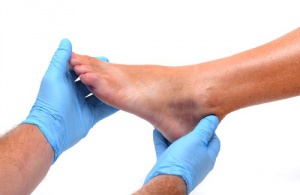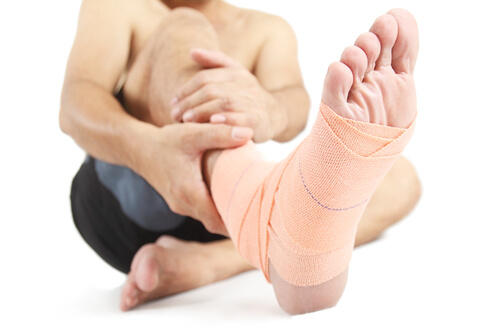The Causes of Swollen Ankles and Feet

If you have swollen ankles and feet for a long period of time, or have other symptoms, it might be a sign of a more serious health problem. Today, we’re going to tell you some of the potential causes of swollen ankles and feet so you can spot problems early on
Potential causes of swollen ankles and feet
Complications from pregnancy
A bit of swelling in the ankles and feet is normal during pregnancy. But sudden or excessive swelling could be a sign of preeclampsia. This is a serious condition that usually starts after the 20th week where your blood pressure shoots up and there’s a lot of protein in your urine.
If you experience severe swelling, or swelling along with other symptoms like abdominal pain, headaches, reduced urine, nausea, vomiting, or changes in vision, see your doctor right away.
Foot or ankle injuries
You can easily get swollen ankles and feet from an injury. Sprained ankles are the most common. They usually happen when you take a bad step and the ligaments holding the ankle stretch too far.
To reduce swelling from a foot or ankle injury, you have to rest and not walk on the injured part of your body. So, use ice packs, wrap the foot or ankle with a compression bandage, and raise the foot on a stool or pillow. If the swelling and pain are severe, or don’t improve with in-home treatment, talk to your doctor.
You might like:
Tips to Relieve Foot Pain at Home
Lymphedema
Another one of the potential causes of swollen ankles and feet is lymphedema. It comes from a buildup of lymphatic liquid in the tissues. It can happen because of problems with the lymphatic system, or having lymph nodes removed.
Lymph is a fluid rich in proteins. It travels through an extensive web of blood vessels and capilaries. Your lymph nodes act as a filter for it, trapping and destroying any unwanted substances like bacteria.
When there is a problem with the blood vessels or lymph nodes, it could stop this fluid from flowing properly. If you don’t treat it, this lymph build-up could slow down wound healing and cause infections and deformations.
Lymphedema is common after radiotherapy or lymph node removal in cancer patients. If you have undergone cancer treatment and have experienced swelling, consult your doctor immediately.
Venous insufficiency
Swollen ankles and feet are often an early warning sign of venous insufficiency. This is a condition where not enough blood comes up from the veins in the legs and feet to the heart. Normally, our veins keep the blood flowing upwards with one-way valves.
When these valves become injured or weakened, the blood that goes down from the heart stays in the soft tissue of your lower extremities, especially the ankles and feet. Chronic venous insufficiency can lead to changes in the skin, ulcers, and infections. If you show symptoms of venous insufficiency, you should see your doctor.
Infection
Infections are another one of the common causes of swollen ankles and feet could also be a sign of infection. People with diabetic neuropathy or other problems with the nerves in the feet have a high risk of foot infection. If you have diabetes, it’s important to inspect your feet daily to see if they have blisters or ulcers.
Nerve damage could numb the pain in your feet and you might not notice the problems soon enough. If you notice that your foot is swollen or has a seemingly infected blister, talk to your doctor right away.
Blood clot
Blood clots that form in the veins in the feet can block the return blood flow from the legs to the heart. If that happens, it can cause swelling in the ankles and feet. Blood clots can be superficial (in the veins just below the skin), or deep (a condition known as deep vein thrombosis).
Deep blood clots can block one or more of the primary veins in the legs. The clots can potentially be lethal if they break loose and travel to the heart and lungs.
If you have swelling in one leg, along with pain, low-grade fever, and possibly a change in the color of that leg, see your doctor right away. You may need to undergo treatment with anticoagulants.
Heart, liver, or kidney disease
In some cases, swelling indicates a problem with the heart, liver, or a kidney disease. Ankles that swell at night could be a sign of salt and water retention, caused by right side heart failure.
Kidney disease could also cause swollen ankles and feet. When the kidneys don’t function properly, liquid can build up in the body.
Liver disease can affect the production of a protein called albumin. This prevents blood from escaping from blood vessels to the surrounding tissue. Insufficient production of albumin could lead to fluid loss. This causes more liquid to build up in the feet and ankles, or even in the abdomen and chest.
If your swelling is accompanied by other symptoms like fatigue, loss of appetite, or weight gain, talk your doctor immediately. If you have trouble breathing, if breathing is painful, or you feel pressure or weight on your chest, go the ER.
Side effects of medication
Many medications have side effects that are also one of the potential causes of swollen ankles and feet. If you suspect that this inflammation could be because of a medication you’re taking, see your doctor.
At the end of the day, it might be worth dealing with the swelling for the sake of the medicine. If the inflammation is more severe, then you might need to switch or change the dosage.
All cited sources were thoroughly reviewed by our team to ensure their quality, reliability, currency, and validity. The bibliography of this article was considered reliable and of academic or scientific accuracy.
- Gasparis AP, Kim PS, Dean SM, Khilnani NM, Labropoulos N. Diagnostic approach to lower limb edema. Phlebology. 2020 Oct;35(9):650-655.
- Hansrani V, Khanbhai M, McCollum C. The Diagnosis and Management of Early Deep Vein Thrombosis. Adv Exp Med Biol. 2017;906:23-31.
- Suehiro K, Morikage N, Yamashita O, Harada T, Ueda K, Samura M, Tanaka Y, Takeuchi Y, Nakamura K, Hamano K. Distribution of Extracellular Fluid in Legs with Venous Edema and Lymphedema. Lymphat Res Biol. 2016 Sep;14(3):156-61.
- Urbanek T, Juśko M, Kuczmik WB. Compression therapy for leg oedema in patients with heart failure. ESC Heart Fail. 2020 Oct;7(5):2012-2020.
- Smyth RM, Aflaifel N, Bamigboye AA. Interventions for varicose veins and leg oedema in pregnancy. Cochrane Database Syst Rev. 2015 Oct 19;2015(10):CD001066.
This text is provided for informational purposes only and does not replace consultation with a professional. If in doubt, consult your specialist.









